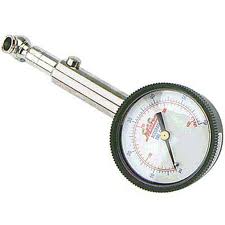
With a digital pressure gauge simply read the number on the screen. Compare that to your vehicles recommended PSI.

Tire Gauge Choices With all this in view its obvious an RVer needs an accurate tire pressure gauge.
How do you read a tire pressure gauge. How to Check Tire Presure. Start with Cold Tires if Possible. Vehicle manufacturers specify PSI literally pounds per square inch of pressure assuming tires are cold.
Check the Manufacturers Recommended PSI. Write Down the PSI for Each Tire. Check Tire Pressure with Your Gauge.
Make sure you have your manufacturers PSI handy when youre checking your tire pressure and then follow these steps. Remove the end caps on your tires air valves dont lose them. Place the tire pressure gauge into the valve stem and press down quickly to get a reading.
Check the PSI reading. Compare that to your vehicles recommended PSI. There are three simple steps involved in measuring a tire s pressure with a pressure gauge.
Get in a steady position to apply the pressure gauge to the valve stem. Apply the gauge forming a good seal between the gauge and the stem and releasing air from the tire into the gauge. If you have any doubt about the accuracy of your tire pressure gauge there are a couple things you can do to check it.
1 You can check the air pressure in a tire with the gauge in question and then check the same tire with another gauge. If youre using the gauge on an air compressor and the pressure in your tires is low pull the trigger on the handle to add air to your tire. Then check the gauge again by reading the tube that pops up.
Continue adding pressure until your tires pressure matches the recommended level as stated by your manufacturer. Here is a five-step process to do it the right way. Make sure the gauge is zeroed-out on a flat surface.
You might be able to adjust the pin to get an actual reading of. In the air push the measuring scale all the way in so the measuring pin sticks out as far as possible. Place the measuring pin.
You can also check the drivers side door for the standard pressure of the tire. Always check the lowest as well as the highest inflation of the tire recommended by the manufacturer. The recommended PSI pounds per square inch for usual vehicles such as cars minivans sedans and mini pickups is 27 to 32.
Tire Gauge Choices With all this in view its obvious an RVer needs an accurate tire pressure gauge. Youll find tire gauges just about anywhere that car stuff is sold. Auto parts stores big box retailers and certainly on the Internet.
Tire gauges come in three basic types. Check your tires cold before youve driven or at least three hours after youve driven. Insert tire pressure gauge into the valve stem on your tire.
If you are using a digital tire gauge like the one pictured the gauge should begin reading the air pressure immediately. A tire gauge measures the air pressure in any pneumatic air-filled wheel or tire. The results are usually read in PSI Pounds of air per Square Inch.
Automobile tires have recommended PSI levels imprinted on the tire itself and included on a chart inside the drivers side door panel. Press the tire gauge on to the valve. If youre using a stick gauge make sure youre using the open end not the side that releases air.
Wait for the pressure reading on the screen. Digital gauges are the most accurate and very easy to read. Most will display air pressure in psi kPa kilopascal or bar barometric or 100 kPa.
Once the tire gauge is pressed on to the valve. Once you know the psi range use your tire gauge by placing it on the valve and pressing down causing the needle on the gauge to move and display the pressure. Alternate between the air pump and gauge until you reach desired pressure.
To make things easier get a pump with a built in gauge. CHECKING TIRE PRESSURE WITHOUT A GAUGE. Unscrew the valve stem cap from the valve stem on the tire.
The valve stem is a black or silver pencil-sized extension near the hubcap about 1 2-3 cm long. 3 Press the air pressure gauge evenly onto the valve stem and record the reading given. Put the pressure gauge into the valve stem making sure the gauge is evenly and firmly pressed onto the stem.
If using a pen-style gauge read the number on the rod that pops out of the sleeve. Read dial pressure gauges like you would a watch with one hand. With a digital pressure gauge simply read the number on the screen.
The absolute pressure in the tire is essentially unchanged. Using atmospheric pressure as reference is usually signified by a g for gauge after the pressure unit eg. 70 psig which means that the pressure measured is the total pressure minus atmospheric pressure.